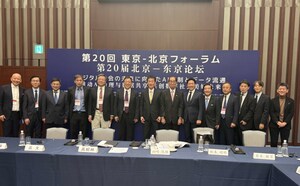Global Journal Observatory: China's Growing Contribution to Journal of Applied Physics
International academic journals are an important platform for publishing scientific research results. They disseminate information on innovation and development, and preserve the human civilization. China has always attached great importance to openness and collaboration, stressing that sci-tech development should align with frontier domains and explore the mysteries of the universe for the good of humanity.
Science and Technology Daily has launched a new column, Global Journal Observatory, with the National Science Library of the Chinese Academy of Sciences. Esteemed editors-in-chief of renowned academic journals and experienced professionals in the field are invited to share how their journal was established, its development prospects, and their insights into the discipline construction to promote scientific exchanges and sharing of research results.
BEIJING, Jan. 8, 2024 /PRNewswire/ -- Andre Anders, the editor-in-chief of the Journal of Applied Physics, shared his insights as follow:
The Journal of Applied Physics was started in 1931, from the realization that physics has profound implications for everyone's real life. When physics made incredible strides from the classical basics of Newton and Maxwell to the quantum and relativistic world of Planck and Einstein, it increasingly affected everyone's life through its applications such as the electric light, radio and radar.
At this juncture, the Journal of Applied Physics was established and has been the journal of choice for over 90 years. The Journal of Applied Physics is not an engineering journal. Namely, it publishes research that bridges the world of fundamental science (addressing what I call the "Why?" question) with the engineering world (the "How-to?" question). For decades, the Journal of Applied Physics has represented the standard of peer-reviewed knowledge in applied physics, and it continues to do so despite many other journals appearing in recent years.
Indeed, both broad-range journals and a plethora of highly specialized journals are available to today's researchers. Still, the work of well-known experts including Nobel Prize-winning researchers is published in the Journal of Applied Physics.
The number of authors from China has steadily and remarkably increased over the last years. Not only has the absolute number of authors and papers increased, but also the fraction of contributions from China. Specifically, 36 percent of submissions and 30 percent of our publications originate from China.
I attribute this to two main factors. For one, China is a large and important country that has greatly invested in its education and research, thus increasing its research output. But perhaps more importantly, the quality of work done by China has increased very notably, leading not only to an increase in submissions but also to a much-increased acceptance rate, which today rivals that of other most advanced nations.
In recent years, realizing the growing importance of China for all sciences, including the various subfields of applied physics, the publisher and the journal connected with Chinese colleagues through AIP Publishing's Beijing office, amplifying the opportunities open to Chinese researchers through invited papers as well as Guest Editorships and contributions to Special Topic issues. The journal appreciates the great effort by Chinese authors to present their work in a foreign language, English.
Publishing is — like all things in modern life — subject to accelerating changes. We, as a team of active researchers and editors supported by a team of professionals in publishing, embrace change. For example, we look for ways to reduce the publishing time while ensuring high standards of peer review. Going all-electronic was a revolution a couple of decades ago. Now, the next revolution is in full swing. Correctly using AI is one, and publishing various models for publishing "open access" is another. For those and other topics, engaging with the Chinese research community is critical and we look forward to many more years of collaboration with our Chinese friends.
Another change is that 2023 marks my 10th and final year as editor-in-chief. I look forward to handing it over to the next editor-in-chief whose name will be announced in the new year, and seeing the journal succeed under this new leadership, and in particular, celebrating the success of the Chinese applied physics community.
Andre Anders has served as the editor-in-chief of the Journal of Applied Physics since July 2014.
SOURCE Science and Technology Daily

WANT YOUR COMPANY'S NEWS FEATURED ON PRNEWSWIRE.COM?
Newsrooms &
Influencers
Digital Media
Outlets
Journalists
Opted In





Share this article